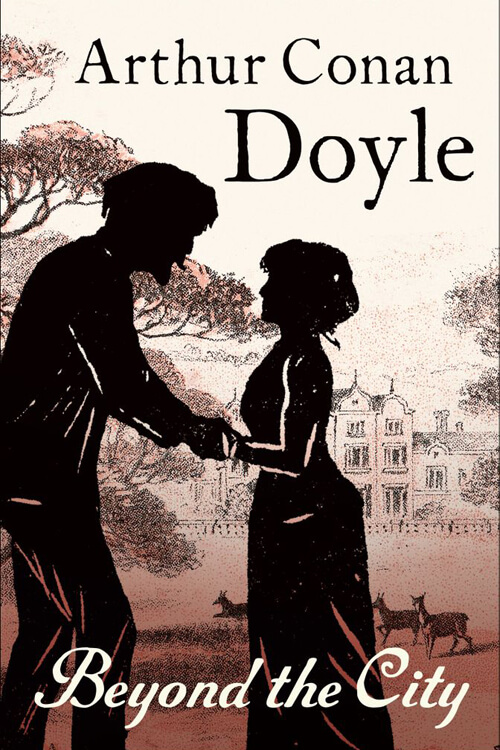
Beyond the City
A four-wheeler had driven up to the gate, and it was at this that the old ladies, peeping out bird-like from behind their curtains, directed an eager and questioning gaze.
The cabman had descended, and the passengers within were handing out the articles which they desired him to carry up to the house. He stood red-faced and blinking, with his crooked arms outstretched, while a male hand, protruding from the window, kept piling up upon him a series of articles the sight of which filled the curious old ladies with bewilderment.
“My goodness me!” cried Monica, the smaller, the drier, and the more wizened of the pair. “What do you call that, Bertha? It looks to me like four batter puddings.”
“Those are what young men box each other with,” said Bertha, with a conscious air of superior worldly knowledge.
“And those?”
Two great bottle-shaped pieces of yellow shining wood had been heaped upon the cabman.
“Oh, I don’t know what those are,” confessed Bertha. Indian clubs had never before obtruded themselves upon her peaceful and very feminine existence.
These mysterious articles were followed, however, by others that were more within their, range of comprehension–a pair of dumbbells, a purple cricket bag, a set of golf clubs, and a tennis racket. Finally, when the cabman, all top-heavy and bristling, had staggered off up the garden path, there emerged in a very leisurely way from the cab a big, powerfully built young man, with a bull pup under one arm and a pink sporting paper in his hand. The paper he crammed into the pocket of his light yellow dust-coat, and extended his hand as if to assist someone else from the vehicle. To the surprise of the two old ladies, however, the only thing that his open palm received was a violent slap, and a tall lady bounded unassisted out of the cab. With a regal wave, she motioned the young man towards the door, and then with one hand upon her hip she stood in a careless, lounging attitude by the gate, kicking her toe against the wall and listlessly awaiting the return of the driver.
Read or download Book
Arthur Conan Doyle
Sir Arthur Ignatius Conan Doyle KStJ, DL (22 May 1859 – 7 July 1930) was a British writer and physician. He created the character Sherlock Holmes in 1887 for A Study in Scarlet, the first of four novels and fifty-six short stories about Holmes and Dr. Watson. The Sherlock Holmes stories are milestones in the field of crime fiction.
Doyle was a prolific writer; other than Holmes’s stories, his works include fantasy and science fiction stories about Professor Challenger, and humorous stories about the Napoleonic soldier Brigadier Gerard, as well as plays, romances, poetry, non-fiction, and historical novels. One of Doyle’s early short stories, “J. Habakuk Jephson’s Statement” (1884), helped to popularise the mystery of the Mary Celeste.
Name
Doyle is often referred to as “Sir Arthur Conan Doyle” or “Conan Doyle”, implying that “Conan” is part of a compound surname rather than a middle name. His baptism entry in the register of St Mary’s Cathedral, Edinburgh, gives “Arthur Ignatius Conan” as his given name and “Doyle” as his surname. It also names Michael Conan as his godfather. The catalogs of the British Library and the Library of Congress treat “Doyle” alone as his surname.
Steven Doyle, publisher of The Baker Street Journal, wrote: “Conan was Arthur’s middle name. Shortly after he graduated from high school he began using Conan as a sort of surname. But technically his last name is simply ‘Doyle’.” When knighted, he was gazetted as Doyle, not under the compound Conan Doyle.
Doyle’s first novels were The Mystery of Cloomber, not published until 1888, and The Unfinished Narrative of John Smith, published only posthumously, in 2011. He amassed a portfolio of short stories, including “The Captain of the Pole-Star” and “J. Habakuk Jephson’s Statement”, both inspired by Doyle’s time at sea. The latter popularised the mystery of the Mary Celeste and added fictional details such as that the ship was found in perfect condition (it had taken on the water by the time it was discovered), and that its boats remained on board (the single boat was missing). These fictional details have come to dominate popular accounts of the incident, and Doyle’s alternative spelling of the ship’s name as the Marie Celeste has become more commonly used than the original spelling.
Between 1888 and 1906, Doyle wrote seven historical novels, which he and many critics regarded as his best work. He also wrote nine other novels, and—later in his career (1912–29)—five narratives (two of novel length) featuring the irascible scientist Professor Challenger. The Challenger stories include his best-known work after the Holmes oeuvre, The Lost World. His historical novels include The White Company and its prequel Sir Nigel, set in the Middle Ages. He was a prolific author of short stories, including two collections set in Napoleonic times and featuring the French character Brigadier Gerard.
Doyle’s works for the stage include Waterloo, which centers on the reminiscences of an English veteran of the Napoleonic Wars and features a character Gregory Brewster, written for Henry Irving; The House of Temperley, the plot of which reflects his abiding interest in boxing; The Speckled Band, adapted from his earlier short story “The Adventure of the Speckled Band”; and an 1893 collaboration with J. M. Barrie on the libretto of Jane Annie.






